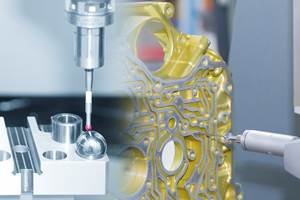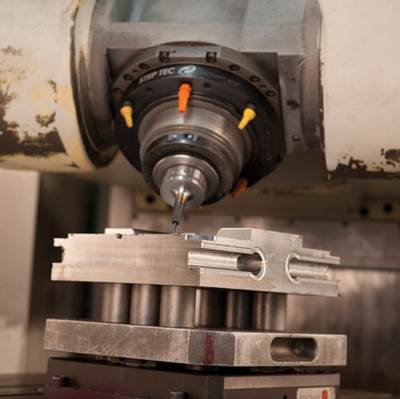Video: Minimizing Mistakes with Laser Scanning CMM
Die Tech & Engineering uses its scanning to CMM to avoid errors by inspecting electrodes prior to EDM.
Share






Video Transcript
Narrator: Traditionally, inspection with a CMM is often performed only at the completion of an assembly or machining process. One mold maker has a different way; at Die-Tech & Engineering, near Grand Rapids, Michigan, inspecting electrodes or components during the mold build process helps prevent surprises and big problems at final inspection.
The slow speed of traditional contact CMMs can be a limitation. At roughly one point per second or less, though inspection can take a lot of time. A laser scanning CMM is much faster, normally collecting thousands of points per second. A laser scanner works by reflecting light off a surface. The reflected light is measured by its location on a sensor, much like a camera. The location is then triangulated to measure each point’s offset from the laser.
Die-Tech & Engineering’s Bill Berry was being pressured to buy a traditional CMM by his customers.
Bill Berry: I avoided buying a CMM until that point, because in my opinion, there was not a value add to owning one of those piece of equipment. Because it was too late. You were just getting a scorecard on what you already did, not a way to improve or prevent mistakes.
N: Investigation revealed that a fast, laser scanning CMM could offer a better solution, but only if he used it during the process, not at the end.
BB: For many years, we were very aware that some of the big problems that can come in the manufacturing of dies and molds are during the build process with all of the various components. Especially in the EDM are that we use, and we didn’t have a good way to inspect those. We incorporated laser scanning CMM into our operations so that we could do in process gauging and reduce the number of mistakes we had and improve the quality before we complete the die.
N: Scanning all of the electrodes before they were used, helped ensure that EDM processes were error free. Once installed, Die-Tech found more uses for it’s scanning laser CMM.
BB: Initially, that was our concept. We need to make sure that our electrodes are precise enough, in a correct position, programmed correctly to use. But, we had enough capacity in the machine that we also integrated scanning of separate, discrete components like corepins, that would validate the machining operations, that were many times, done by skilled craftsmen, outside of the control of the engineering department, on conventional grinding equipment, or other methods. The risk for not completely inspecting those things was so great, that we found a way to inspect them with very little additional cost.
N: Note the simplicity of set-up for scanning these corepins. A generic set-up sheet for the corepin scanning is simply taped on to a blank palette, and the pins are then just set on that drawing to identify them. The scanning laser software automatically finds each pin’s alignment, based on the scanned data.
Today, Die-Tech not only inspects the electrodes before they go into the EDM, the shop also verifies the burns set-up instructions on the virtual part. The electrode is scanned, the burns set-up instructions from the tool path department are entered into the laser scanning CMM system, and then the scanned electrode data is located on the part’s detail. This provides complete verification of the electrode and burn process in a virtual environment, before the steel is burned in the EDM.
Here’s an error discovered by the laser scanning CMM. Each electrode was properly designed, and set-up instructions were correct. Still, when burned in the insert, the clearance portion of one electrode, would have violated the steel on the adjacent geometry in one of its’ burned positions. The laser scanning CMM caught the problem in the virtual world, before actually starting to burn the real insert. The violating area was relieved from the electrodes, averting a big problem.
At Die-Tech, the shop doesn’t only inspect after machining is already done. For EDM the shop thoroughly inspects before machining, so errors never make it to the real world.
Click here to learn more about supplier Nikon Metrology.
Related Content
Using Digital Tap Testing to Measure Machining Dynamics
Tool-toolholder-spindle-machine combinations each have a unique vibration response. We can measure the response by tap testing, but we can also model it.
Read MoreRethink Quality Control to Increase Productivity, Decrease Scrap
Verifying parts is essential to documenting quality, and there are a few best practices that can make the quality control process more efficient.
Read MoreOrthopedic Event Discusses Manufacturing Strategies
At the seminar, representatives from multiple companies discussed strategies for making orthopedic devices accurately and efficiently.
Read MoreHow to Evaluate Measurement Uncertainty
Manufacturing and measurement are closely coupled. An important consideration for the use of measurement results is the associated measurement uncertainty. This article describes common metrology terms and provides an example uncertainty analysis.
Read MoreRead Next
Find Your Speed Outside of Machining
This short-lead-time mold shop achieves its most significant time savings by looking outside the machining cycle. However, one of those elements outside the cycle—palletized setup—ultimately led to cycle time savings via five-axis machining.
Read MoreLast Chance! 2025 Top Shops Benchmarking Survey Still Open Through April 30
Don’t miss out! 91ÊÓƵÍøÕ¾ÎÛ's Top Shops Benchmarking Survey is still open — but not for long. This is your last chance to a receive free, customized benchmarking report that includes actionable feedback across several shopfloor and business metrics.
Read MoreAMRs Are Moving Into Manufacturing: 4 Considerations for Implementation
AMRs can provide a flexible, easy-to-use automation platform so long as manufacturers choose a suitable task and prepare their facilities.
Read More





















